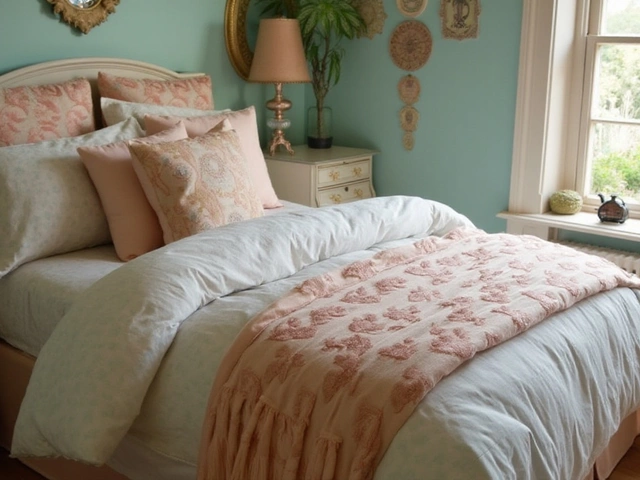Bedding is a word that brings to mind the soft, comforting layers we nestle into each night. But when language evolves, so too do the meanings of words we think we know well. Bedding has shuffled its way into modern slang, with a new twist that has caught the curiosity of many.
In this article, we take a cozy dive into how this term is used beyond its fluffy origins. As with many slang terms, its meaning depends greatly on the context in which it's used, leading to a variety of interpretations. Whether you're a vocabulary enthusiast or just curious about modern slang, this exploration of 'bedding' proves to be as layered as your favorite duvet. Let's unravel the shifts in language and see how a simple word can carry different weights in today's world.
- Traditional Meaning of Bedding
- Origin of Slang Usage
- Common Contexts and Examples
- Cultural Impact and Perception
- Tips for Understanding Modern Slang
Traditional Meaning of Bedding
When we first think of bedding, thoughts turn to essentials that create a conducive environment for restful sleep. Traditionally, bedding encompasses a suite of textile products designed for a bed, including sheets, blankets, comforters, quilts, and pillowcases. These items, chosen for both function and style, play a pivotal role in ensuring we achieve the deep, restorative sleep that humans have craved since time immemorial. They not only provide warmth and comfort but also contribute to the aesthetic of a bedroom, making it a personal retreat from the world.
The evolution of bedding materials through time tells a fascinating story of human innovation and cultural practices. In ancient civilizations, materials such as straw and animal skins laid the groundwork for what would become the bedding of future eras. As technology advanced, the Industrial Revolution brought forth the widespread availability of cotton, revolutionizing how society viewed comfort and coziness. What was once a luxury for the elite became a staple for all households. Today, the array of materials available—from crisp cotton percale to lush linen and cutting-edge microfiber—offers something for every taste and need.
Bedding does more than adorn a bed; it reflects personal choices and lifestyle. People may choose bedroom textiles based on factors like climate, personal warmth preferences, and even allergies. The growing emphasis on sustainable living has prompted many to select ethically sourced and eco-friendly materials, such as organic cotton or bamboo, pushing the boundaries of comfort and style. This move aligns with a global shift towards more environmentally conscious consumer habits, further emphasizing the important role bedding plays in our everyday lives.
Quality bedding is not just about looks but also about health. The right choice can significantly impact sleep hygiene, a crucial aspect of well-being. Sleep experts have long touted the benefits of investing in breathable, moisture-wicking materials that align with the body's natural temperature and circadian rhythms. This scientific approach to choosing the right bedding underscores its importance to restful sleep, essential for mood regulation, cognitive function, and general health. As Dr. Michael Breus, a renowned sleep expert, aptly notes,
"Investing in quality sleep is investing in your future, and the right bedding can be a game-changer."
In various cultures, bedding holds symbolic importance. In some traditions, bedding items are given as wedding gifts, representing wishes for warmth and prosperity. The choice and presentation of these items can be a display of love, care, and status. This cultural richness adds another layer to bedding's traditional meaning, highlighting its integration into important life events and cultural customs. The combination of personal, cultural, and functional dimensions makes bedding much more than mere utilitarian objects, spanning a history as rich and varied as the fabrics themselves.
Origin of Slang Usage
The journey of words from literal meanings to slang is a fascinating one that often involves cultural shifts and social trends. The term bedding, originally known for its reference to the cozy ensemble that dresses a mattress, underwent such a transformation. This metamorphosis in meaning can be traced to subtle changes in everyday conversations and the influence of media.
Historically, slang emerges in subcultures that value the art of metaphor and playful language. In the realm of modern slang terms, bedding has become an informal reference not just to something physical but to a range of intimate activities. During the late 20th and early 21st centuries, people began using bedding as a euphemism, citing its association with beds—symbolic of rest and privacy—as an ideal metaphorical base. As online communications grew, the word embedded itself into digital conversations where brevity and innuendo became staples. Language has always been a marker of societal progress. Its playful twists demonstrate not only a relaxation of taboos but also signify an embrace of more open discussions about personal topics.
Some language experts attribute the spread of this particular bedroom slang to the influence of movies and music, where innuendo often thrives. Artists and screenwriters, with their knack for creativity, adopt and spread these terms within their works, leading fans to incorporate them into their vernacular. The repeated use in popular culture made this slang commonly understood and adopted across different social groups. As Robert MacNeil, a noted authority on language evolution, once quipped, "Words are like time travelers, dressed differently for each era they visit."
"As words evolve, they reflect not only changes in fashion but also shifts in the fabric of society." — Robert MacNeil
It is important to observe how quickly phrases catch on with the advent of social media, where slang becomes viral within hours. Platforms like Twitter and TikTok serve as melting pots of bedroom slang, effectively demonstrating how quickly a word can switch from niche usage to mainstream. Perhaps it is this malleability that keeps language both unpredictable and interesting, ever moving with the flurry of human interaction. As we break down these shifts, it becomes clear just how embedded slang terms like bedding are, functioning as both markers of conversational intimacy and shifting cultural norms.

Common Contexts and Examples
When we look at the term bedding in its slang context, it captures quite a transformation. In everyday conversations, especially among younger people, 'bedding' has become a playful euphemism, often referring to the act of sharing a bed with someone in a romantic or intimate manner. This usage is typically found in relaxed settings, where language flourishes with casual creativity. One might hear phrases like, "They've been bedding together for a while," showcasing this less formal twist on language.
The online world, particularly social media platforms and forums, serve as fertile ground for the propagation of these slang interpretations. Here, users adopt 'bedding' alongside emojis or gifs to add layers of meaning or humor. It's an interesting linguistic evolution, reflecting how community interactions redefine words. Often, these come across in anecdotes or humorous exchanges, like when someone tweets about 'bedding in' for the weekend, implying a cozy time spent in more ways than one.
As noted in a feature by The Guardian, language is a living entity, shaped by cultural shifts and generational changes.
"Slang often serves as a vehicle for social bonding among peers, a way of crafting identity and belonging," the article suggests. This captures why a term like 'bedding' could evolve from its static use into something more dynamic and engaging.
The nuances don't end there. In a more metaphorical sense, 'bedding' can suggest the foundation or underlying layer of a situation, much like bedding layers form the base of a comfortable bed. This secondary connotation might surface in storytelling contexts, where a seasoned writer weaves the word into dialogue or narrative layers to hint at underlying themes or relationships without being overtly explicit. This clever use lends depth and subtlety to character interactions, keeping readers intrigued.
Beyond verbal exchange, the slang meaning has found its way into media like films and music. Lyrics might playfully suggest 'bedding' as part of a romantic escapade, further embedding this slang into pop culture. Filmmakers often hint at relationships through visual metaphors, such as a lingering shot on an unmade bed, whispering the implication without using a single word. Bedding slang thus becomes a storytelling tool as much as it is a modern parlance.
Cultural Impact and Perception
Language is a living entity, constantly evolving to reflect the nuances of the time. The adoption of the term 'bedding' in modern slang is a fascinating example of how words can carry dual roles in both our private and public lives. On one hand, there is the literal side of bedding, which is essentially a staple in our daily routines. On the other, its slang usage often allows it to traverse into more intimate, and sometimes, lighter colloquial exchanges. This duality speaks volumes about our increasingly complex social contexts and interpersonal relationships. Linguists often note that such changes indicate more than mere language play; they mirror shifts in societal norms and values. For instance, as societies grow more open about intimacy and relationships, slang terms like this one appear more frequently in both casual and media-driven conversations.
The cultural acceptance of the slang version of bedding reflects a broader trend toward candid expression in personal matters. In the internet age, where communication is rapid and sometimes screen-deep, inventiveness in language becomes key. It also signifies a kind of linguistic creativity among the younger demographic, who are often the trendsetters of slang. Yet, this does not remain confined to the young. Older generations witness and gradually adopt these shifts, sometimes with curiosity, as they engage with media or through conversations with younger cohorts. This social diffusion can gently challenge traditional communication norms, calling into recalibration elements like censorship and privacy in language.
The media plays a pivotal role in shaping perceptions around slang and its adoption. Pop culture, especially through music and film, often brings these terms into the mainstream, transforming niche vernaculars into everyday vocabulary. Consider how a hit television show might use the term in a relatable or humorous context, linking it directly to the audience's understanding. In fact, terminology such as this enjoys mainstream staying power precisely because it resonates with shared experiences depicted on screen or sung about in popular tracks. As eloquently noted by communications expert John McWhorter, "Slang is the language of connection, an ever-evolving code between those who want to belong, recognize, and share a moment or sentiment."
"Slang is the language of connection, an ever-evolving code between those who want to belong, recognize, and share a moment or sentiment." – John McWhorter
The perception of slang can be subjective, rooted deeply in individual experiences and cultural backgrounds. Educational systems and formalized language institutions often wrestle with the inclusion of slang, debating its place in languages that are traditionally taught. This reflects a broader tension between preserving linguistic purity and embracing evolution. While academia might resist certain slang terms, mainstream dictionaries, particularly digital ones, have begun to embrace this dynamic vocabulary. It's a fascinating dichotomy: the written and spoken worlds pulling in different directions, yet collectively marching toward a more inclusive and vibrant tapestry of communication. The integration and understanding of slang like 'bedding' within cultural contexts reveal much about how we navigate the blend of old and new within the language we love.

Tips for Understanding Modern Slang
In a world where language is continuously evolving, keeping up with modern slang can feel like a daunting task, yet it is incredibly rewarding. One way to grasp the concept of modern slang, like the dual meaning of bedding slang, is to dive into its context. Pay close attention to conversations, television shows, and social media platforms where these terms emerge. This immersive approach helps you understand the tone and circumstances in which the terms are used. Modern slang often embodies characteristics of the current generation, informed by popular culture, technology, and shared experiences.
Another helpful tip is to engage with a variety of media. Watching TV series, movies, and listening to music gives you insight into how and why certain words gain popularity. For instance, watching a popular Netflix show or scrolling through TikTok might give you firsthand experience of terms being coined or used in unexpected ways. Participating in online forums like Reddit where discussions around new language trends ensue can also offer valuable insights. Sometimes slang originates from specific communities or subcultures before spreading more widely.
"Slang is an ever-evolving reflection of our culture, capturing the zeitgeist of the moment," stated sociolinguist Dr. Amanda Smith. "Understanding slang means stepping into a linguistic playground full of creativity and expression."
It's also beneficial to keep an open mind. Slang is often playful and breaks traditional language rules. It is crafted creatively and should be approached with curiosity rather than rigid thinking. This open approach fosters adaptability and can improve communication across different generations. As language users, we should embrace the elasticity of words and the ingenuity behind their transformation. For instance, linguists suggest that slang words become markers of identity within groups, creating a sense of belonging among those who use them.
Moreover, it might be useful to look up slang terms in online dictionaries dedicated to modern language. Websites like Urban Dictionary serve as dynamic repositories for contemporary slang. While they may not always offer the most polished definitions, they do provide a wealth of user-submitted meanings that can give you a starting point. Engaging with these resources makes it easier to be part of conversations involving contemporary jargon. Just remember to cross-reference with multiple sources to gain a clearer understanding.
Lastly, it is worth remembering that modern slang can often be transient. Words can rise and fall out of use as quickly as they appeared. Staying connected with younger generations and involving yourself in interactive discussions helps you remain in the loop. Understanding that language change is a cycle means accepting that today's trend might not be a permanent fixture in the linguistic landscape. However, tracking their journey offers fascinating insights into cultural shifts. For more accurate interpretations, context remains key, and every new word is an opportunity to learn.







